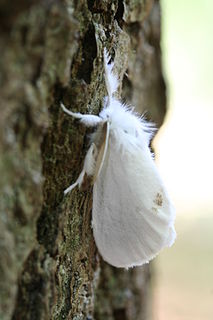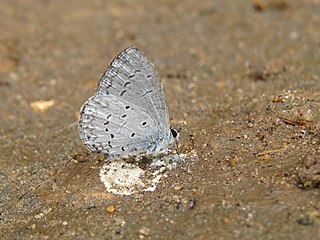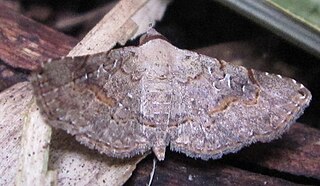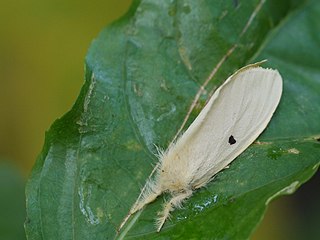
The yellow-tail, goldtail moth or swan moth is a moth of the family Erebidae. The species was first described by Johann Kaspar Füssli in 1775, and has commonly been placed within the related genus Euproctis. It is distributed throughout Europe to the Urals, then east across the Palearctic to Siberia and south to India and Sri Lanka.

Celastrina lavendularis, the plain hedge blue, is a small butterfly found in Sri Lanka, India, and Indomalayan realm that belongs to the lycaenids or blues family.

Cigaritis elima, the scarce shot silverline, is a species of lycaenid or blue butterfly found in Sri Lanka and India. The species was first described by Frederic Moore in 1877.

Rhesala is a genus of moths of the family Erebidae. The genus was erected by Francis Walker in 1858.

Euproctis is a genus of tussock moths in the family Erebidae described by Jacob Hübner in 1819. Species are cosmopolitan, widespread throughout Palearctic, African, Oriental and Australian regions. Molecular phylogenetic studies indicate that the genus as presently understood comprises a large number of unrelated lineages, only a few of which have names, and is therefore in serious need of revision.
Barsine defecta is a moth of the family Erebidae first described by Francis Walker in 1854. It is found in Sri Lanka, Nepal, Thailand and Vietnam. It is the type species of genus Barsine.
Artaxa angulata is a moth of the family Erebidae first described by Shōnen Matsumura in 1927. It is found in Taiwan, Myanmar, India, Pakistan, Sri Lanka, Malaysia, Singapore and Indonesia.
Sphrageidus xanthorrhoea is a moth of the family Erebidae first described by Vincenz Kollar in 1848. It is found in India, Sri Lanka, Java and Indonesia. It was once classified under the genus Euproctis, where it is accepted by some authors.
Euproctis bimaculata is a moth of the family Erebidae first described by Francis Walker in 1855. It is found in India, Sri Lanka and Thailand.
Euproctis fraterna is a moth of the family Erebidae first described by Frederic Moore in 1883. It is found in the Maldives, India, Sri Lanka and the Seychelles.
Euproctis fulvipuncta is a moth of the family Erebidae first described by George Hampson in 1893. It is found in India and Sri Lanka.

Euproctis lunata, the castor hairy caterpillar, is a moth of the family Erebidae. The species was first described by Francis Walker in 1855. It is found in India, Pakistan, Sri Lanka and Thailand.

Euproctis latifascia is a moth of the family Erebidae first described by Francis Walker in 1855. It is found in India, Sri Lanka and Taiwan.
Euproctis rhoda is a moth of the family Erebidae first described by Frederic Moore in 1879. It is sometimes classified as a subspecies of Euproctis howra. It is found in India, Sri Lanka, Myanmar, the Andaman Islands and Australia.
Euproctis semisignata is a moth of the family Erebidae first described by Francis Walker in 1865. It is found in India and Sri Lanka.

Euproctis varians is a moth of the family Erebidae first described by Francis Walker in 1855. It is found in India, Sri Lanka, the Maldives, Celebes and China.
Rivula bioculalis is a moth of the family Erebidae first described by Frederic Moore in 1877. It is found in Sri Lanka, the Andaman Islands, the Indian subregion, Taiwan, Thailand and Borneo.
Cheromettia ferruginea is a moth of the family Limacodidae first described by Frederic Moore in 1877. It is found in Sri Lanka.
Thosea cervina, is a moth of the family Limacodidae first described by Frederic Moore in 1877. It is found in Sri Lanka and India.
Manatha albipes is a moth of the family Psychidae first described by Frederic Moore in 1877. It is found in Sri Lanka.








